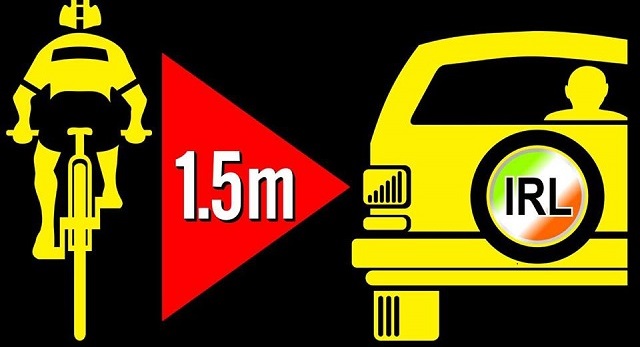The Stayin’ Alive at 1.5 campaign in Ireland, the campaign to introduce a 1.5m passing distance for motorists overtaking bicycles has been raised at the Dáil, by Regina Doherty of the Fine Gael party.
The full discussion is outlined below:
Regina Doherty (Meath East, Fine Gael)
I thank the Minister for attending. I ask the Minister to endorse and support the campaign that has been mounted by cyclist organisations, cycle clubs and even some of our professional cyclists in recent times. If he is not aware of it, I will give some background.
The Stayin’ Alive at 1.5 campaign seeks to pursue the adoption of a new law requiring motorists to give cyclists 1.5 metres of clearance when they are being overtaken from the rear. It is a two-pronged campaign that is being undertaken on Facebook and other social media, and more importantly through lobbying individual Deputies. Through that medium it was brought to my attention, and I carried out some research.
The current law in the Rules of the Road only suggests that a driver should give extra space when overtaking a cyclist and makes no mention of minimum clearance. The aim of Stayin’ Alive at 1.5 is to have this distance clearly defined as 1.5 m and to replace the word “should” with the word “must”. The current law on dangerous overtaking only states: “A driver shall not overtake, or attempt to overtake, if to do so would endanger, or cause inconvenience to, any other person.” However, I am not sure that the driver of a 40-foot truck or a very large bus has full cognisance of how intimidating the vehicle is to a cyclist on the road. The very small distance that is currently being observed between drivers of very large vehicles, and even some cars, and cyclists on the road is causing such fear among cyclists that they have mounted this campaign.
I ask the Minister to look at how infringement of the current law is being policed, for want of a better word. I do not believe it is being policed in any meaningful way. I cite a very personal example. I suppose all politics is personal, because it does not affect one until it comes into one’s home. A few weeks ago an incident happened involving my husband, who is an avid cyclist, and a very large bus. He felt extremely vulnerable one evening. When they caught up with each other at traffic lights and he went to take a photograph of the bus, the driver of the bus got out and was exceptionally aggressive both verbally and physically with him. That makes the cyclist even more vulnerable. It brought home to me that the drivers on the road do not have the respect for cyclists that they should have. While we are not talking about all people, many people do not see cyclists as legitimate road users. This campaign is aimed at making people realise that cyclists are legitimate road users. They are not just adults; many of them are children, and we need to recognise that they have a right to be on the road. They do not have any less of a right to be on the road just because they do not pay road tax.
We need to recognise that cyclists are vulnerable. The Minister could make a clear statement by changing the law to define the minimum overtaking distance as 1.5 m and to change the word “should” to “must”. It would be a clear indication from Government that we respect cyclists and appreciate that they are vulnerable, given their position, and that we will do everything we can to ensure they can use the roads safely.
Paschal Donohoe (Dublin Central, Fine Gael)
I thank the Deputy for raising this important matter with me. As she will be aware, last year 12 cyclists died on our roads. This compares with five in 2013 and eight in 2012, which is absolutely unacceptable. I am very much in favour of promoting the wider use of cycling.
The Deputy is entirely correct that a cyclist on the road is a legitimate road user with the same expectation of safety and respect as somebody in a car. Whether they have paid car tax is not the issue. They are using a road with the expectation of being able to commute safely. That is a right which should be respected and upheld. The other side of the coin is that they have responsibilities, as do other road users. I am confident that the overwhelming majority of cyclists are aware of those responsibilities and discharge them very well. I certainly agree with the Deputy that the cyclist on the road is a legitimate road user who should be conferred with the same respect as any other road user using any other type of vehicle.
There is no single measure which, alone, will work to ensure cyclists’ safety. However, the provision of cycle lanes and how we delineate space for cyclists on roads are still a major contribution to responding to some of the issues the Deputy raised. The Road Safety Authority is engaged on an ongoing basis in promoting safe cycling. This involves providing information and campaigning on issues such as the wearing of helmets and high visibility clothing, and campaigns designed to raise driver awareness of cyclists. In that regard, its campaign includes a specific reference to drivers leaving a 1.5 m clearance when overtaking cyclists. Campaigns include information in schools, booklets, advertising campaigns and engaging with cycling groups during the annual bike week. Indeed, I met representatives of cycling.iea number of weeks ago to discuss this and other matters with them.
I am familiar with the “Stayin’ Alive at 1.5” campaign, which campaigns for the adoption of a law requiring motorists to give cyclists a minimum of 1.5 m clearance when passing from the rear. Currently, the law states that a driver shall not overtake, or attempt to overtake, if to do so would endanger or cause inconvenience to any other person. Dangerous overtaking is an offence carrying a fixed charge penalty of €80, with three penalty points on payment of a fixed charge and five on conviction in court. The regulations do not specify overtaking distances in respect of any kind of vehicle, be it a car, pedal cycle, motorcycle or otherwise. Depending on the circumstances, a motorist overtaking a cyclist in dangerous proximity or hitting a cyclist while overtaking could be charged with dangerous overtaking.
I am aware of the campaign referred to by the Deputy, as was my predecessor. However, I am not convinced of the benefits of fixing a passing distance in law. The reason is the difficulty of enforcing it if enshrined in primary legislation. Such a law would only be enforceable in circumstances where a member of An Garda Síochána witnessed a car overtaking a cyclist at a dangerously close distance. Even then, it would be difficult to prove the specific passing distance.
On foot of the Deputy raising this issue, I would be happy to meet the group with the Deputy to respond on the issue. There are genuine difficulties in respect of implementing what the group is seeking, but given that the Deputy has raised the matter I will meet the group with her in the coming months to explain these challenges and to see if there are other ways to deal with this.
Regina Doherty (Meath East, Fine Gael)
I appreciate that and I will take the Minister up on his offer. I am not denying that it would be difficult to pass a law because it would be difficult to police it. However, we have the same situation, if not worse, with the current law.
I am sorry to be personal about this, but the person I am discussing made the complaint to the Garda and was told that unless somebody saw that there were only inches between the cyclist and the bus, it was irrelevant. The fact that the bus driver got out and made the cyclist feel more vulnerable is not breaking the law; it is just a bit of argy-bargy. Until we define what is acceptable practice clearly in the law, so we can make people aware of acceptable practice and change their current practices, there will continue to be vulnerable cyclists on the road.
The cycle lanes, greenways and anything we can do to encourage people to get more active, be it on the road or for pleasure, are wonderful. I know the Minister truly supports that. I will take him up on the offer of the meeting. If the law we are currently seeking cannot be found to be enforceable, perhaps we will find some other mechanism to ensure that people are less vulnerable than they are today, which is the ultimate goal of Cycling Ireland and everybody who wishes people to be safe on the road from a cycling perspective.
Paschal Donohoe (Dublin Central, Fine Gael)
I will meet the group with the Deputy. It might not be in the immediate future, but we will meet in the coming months about this.
My overall concern is the difficulty of enforcing a law which might well give a short-term benefit, because it would likely lead to a rise in awareness of the matter if such a law were to be implemented, but in the medium to long term that could be diluted by challenges in enforcing it. The Deputy made the point that the Garda said it could not respond to the incident the Deputy described because it needed a witness or proof. Unfortunately, that illustrates the type of difficulty we face when we seek to implement primary law. Once something is enumerated in primary law, the burden of proof is high. That is why there is a challenge with this matter, which we can discuss.
The “Stayin’ Alive at 1.5” campaign makes reference to a law which was implemented in Queensland from the middle of April 2014 for a two year period. This puts in place a minimum distance of 1 m when passing cyclists in a 60 km/h or less speed zone and 1.5 m when the speed limit is over 60 km/h. This law is the first of its kind in Australia and it might well be appropriate to look at the impact of that law and see what evidence it has yielded. The Road Safety Authority has indicated that it will examine practice in this area in other countries.
I see that Deputy Cannon is present and I am aware that he is very interested in this matter. He has raised it with me previously. Perhaps the meeting we have referred to is something we could approach together. I have outlined the challenges that exist but with Deputy Doherty and Deputy Cannon we can engage with the group on the matter.









